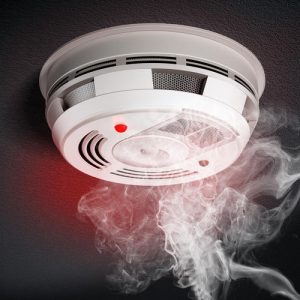Fire Prevention
10 Steps to Home Fire Safety
- Have a working smoke alarm on each level and in each bedroom of your home.
- Never leave cooking unattended and always set a timer.
- Keep items that can burn (i.e., dish towels, paper, wood cutting boards, etc.) away from all cooking equipment.
- Have chimneys and heating equipment inspected annually.
- Clean out dryer lint trap before each use and clean vent pipe quarterly or more frequently if you notice clothing is taking longer to dry.
- Never smoke in bed or where medical oxygen is in use.
- Have all electrical work completed by a qualified electrician.
- Avoid using extension cords as a substitute for permanent wiring.
- Keep space heaters at least 3 feet away from items that can burn and be sure to plug heater directly into wall outlet.
- Create and practice a home fire escape plan with everyone in your home.
Carbon Monoxide Alarms
What is Carbon Monoxide?
Carbon Monoxide (CO) is called the invisible killer because the gas cannot be seen or smelled. CO is created when fuels (such as gasoline, wood, coal, natural gas, propane, oil, and methane) burn incompletely. In the home, heating and cooking equipment that burn fuel are potential sources of CO. Vehicles or generators running in an attached garage or near an open window can also produce dangerous levels of CO.
The dangers of CO exposure depend on a number of variables, including the victim’s health and activity level. Infants, pregnant women, and people with physical conditions that limit their body’s ability to use oxygen (i.e. emphysema, asthma, heart disease) can be more severely affected by lower concentrations of CO than healthy adults would be. A person can be poisoned by a small amount of CO over a longer period of time or by a large amount of CO over a shorter amount of time.
Your home should have a CO alarm if:
- You pay a Vectren bill or have any fuel powered appliances in your home (furnace, stove/oven, water heater, dryer, etc.).
- You have an attached garage.
- You have a fireplace.
What do I need to know about Carbon Monoxide alarms?
- CO alarms can be purchased at most hardware stores. Kettering Fire Department maintains a limited number of carbon monoxide alarms for Kettering residents who are unable to afford one.
- Install and replace CO alarms by following the manufacturer’s recommendations.
- Install a CO alarm outside each sleeping area and on every level of your home.
- Test each CO alarm monthly and replace the battery at least once per year.
- If the CO alarm sounds, make sure everyone in the home moves outdoors and call the fire department from a fresh air location.
Smoke Alarms
Why do I need them?
 Modern home furnishings cause home fires to burn hotter and faster while creating highly toxic smoke. Two thirds of home fire deaths happen in homes with no smoke alarms or no working smoke alarms. Smoke alarms are needed to ensure that everyone in your home will have enough time to exit safely if a fire starts.
Modern home furnishings cause home fires to burn hotter and faster while creating highly toxic smoke. Two thirds of home fire deaths happen in homes with no smoke alarms or no working smoke alarms. Smoke alarms are needed to ensure that everyone in your home will have enough time to exit safely if a fire starts.
What do I need to know about smoke alarms?
Smoke alarms can be purchased at most hardware stores. American Red Cross can provide and install smoke alarms for residents who are unable to afford them. You may call American Red Cross at 937-221-7540 and make an appointment to have smoke alarms installed throughout your home.
Smoke alarms should be installed in the following locations:
- Inside each sleeping room
- Outside each sleeping area
- On each level of the home
- At least 10 feet from a cooking appliance (prevent false alarms)
- Large homes may need extra smoke alarms
For the best protection, it is recommended to have both ionization and photoelectric smoke alarms in your home.
Replace smoke alarms in your home every 10 years.
Test each smoke alarm monthly and replace the battery at least once per year.
Create and practice an emergency evacuation plan with everyone in your home. This evacuation plan should be followed whenever a smoke alarm sounds.

